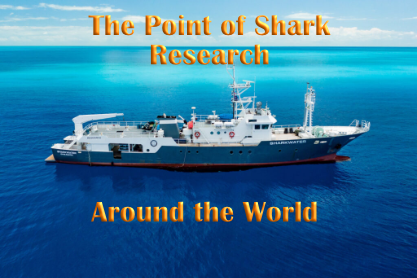
Hundreds, if not thousands, of sharks are being tagged every year by scientists around the world. Piles and piles of data is being accumulated. What exactly does that mean or lead to? The reality is, we can tag every shark in the world and accumulate millions of points of data, and publish thousands of peer-reviewed scientific papers, but to what end? All the tagging and all the data in the world will not protect sharks unless that data is used to change international policy to enact greater protection, such as the establishment of marine protected areas, local no-catch zones, and no-catch zones with nation to nation cooperation. Sharks are highly migratory, making them shared sharks. Eliminating the international trade of shark products is also critical, which is a major component of the shark fins trade. This year is an important year to try and change international policies. CITES is an international agreement between governments. Its aim is to ensure that international trade in specimens of wild animals and plants does not threaten the survival of the species.

How Does CITES Work?
CITES works by subjecting international trade in specimens of selected species to certain controls. All import, export, re-export and introduction from the sea of species covered by the Convention has to be authorized through a licensing system. Each Party to the Convention must designate one or more Management Authorities in charge of administering that licensing system and one or more Scientific Authorities to advise them on the effects of trade on the status of the species. The species covered by CITES are listed in three Appendices, according to the degree of protection they need.
Appendices I and II
Appendix I includes species threatened with extinction. Trade in specimens of these species is permitted only in exceptional circumstances.
Appendix II includes species not necessarily threatened with extinction, but in which trade must be controlled in order to avoid utilization incompatible with their survival.
The Conference of the Parties (CoP), which is the supreme decision-making body of the Convention and comprises all its Parties, has agreed on a set of biological and trade criteria to help determine whether a species should be included in Appendices I or II. At each regular meeting of the CoP, Parties submit proposals based on those criteria to amend these two Appendices. Those amendment proposals are discussed and then submitted to a vote.
Appendix III
This Appendix contains species that are protected in at least one country, which has asked other CITES Parties for assistance in controlling the trade. Changes to Appendix III follow a distinct procedure from changes to Appendices I and II, as each Party’s is entitled to make unilateral amendments to it.
A specimen of a CITES-listed species may be imported into or exported (or re-exported) from a State party to the Convention only if the appropriate document has been obtained and presented for clearance at the port of entry or exit.
Appendix-I
- An import permit issued by the Management Authority of the State of import is required. This may be issued only if the specimen is not to be used for primarily commercial purposes and if the import will be for purposes that are not detrimental to the survival of the species. In the case of a live animal or plant, the Scientific Authority must be satisfied that the proposed recipient is suitably equipped to house and care for it.
- An export permit or re-export certificate issued by the Management Authority of the State of export or re-export is also required. An export permit may be issued only if the specimen was legally obtained; the trade will not be detrimental to the survival of the species; and an import permit has already been issued. A re-export certificate may be issued only if the specimen was imported in accordance with the provisions of the Convention and, in the case of a live animal or plant, if an import permit has been issued. In the case of a live animal or plant, it must be prepared and shipped to minimize any risk of injury, damage to health or cruel treatment.
Appendix-II
- An export permit or re-export certificate issued by the Management Authority of the State of export or re-export is required. An export permit may be issued only if the specimen was legally obtained and if the export will not be detrimental to the survival of the species. A re-export certificate may be issued only if the specimen was imported in accordance with the Convention.
- In the case of a live animal or plant, it must be prepared and shipped to minimize any risk of injury, damage to health or cruel treatment.
Appendix-III
- In the case of trade from a State that included the species in Appendix III, an export permit issued by the Management Authority of that State is required. This may be issued only if the specimen was legally obtained and, in the case of a live animal or plant, if it will be prepared and shipped to minimize any risk of injury, damage to health or cruel treatment.
- In the case of export from any other State, a certificate of origin issued by its Management Authority is required.
- In the case of re-export, a re-export certificate issued by the State of re-export is required
Get Involved!
NearZero Discovery would like to encourage you to get involved with Fins Attached, and help them expand our knowledge, understanding and protection of sharks. Join us in donating towards acoustic tags and we will match up to $2,500.00 to purchase additional acoustic tags for use in Fins Attached shark research. Click Here to Donate
To learn more about Fins Attached, read our blog: Why Sponsor Fins Attached?
Reference: Originally Shared by Fins Attached click here to read original





